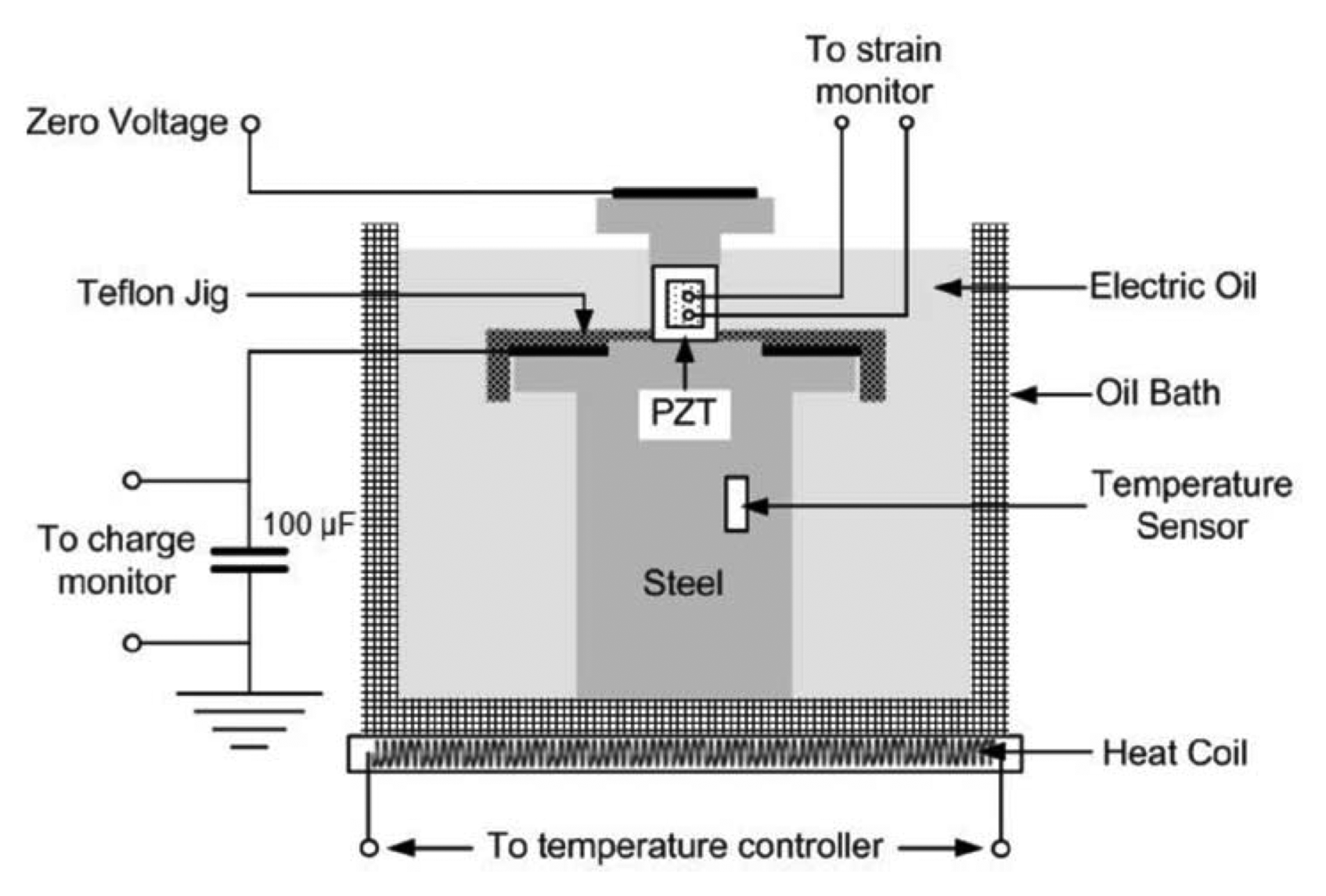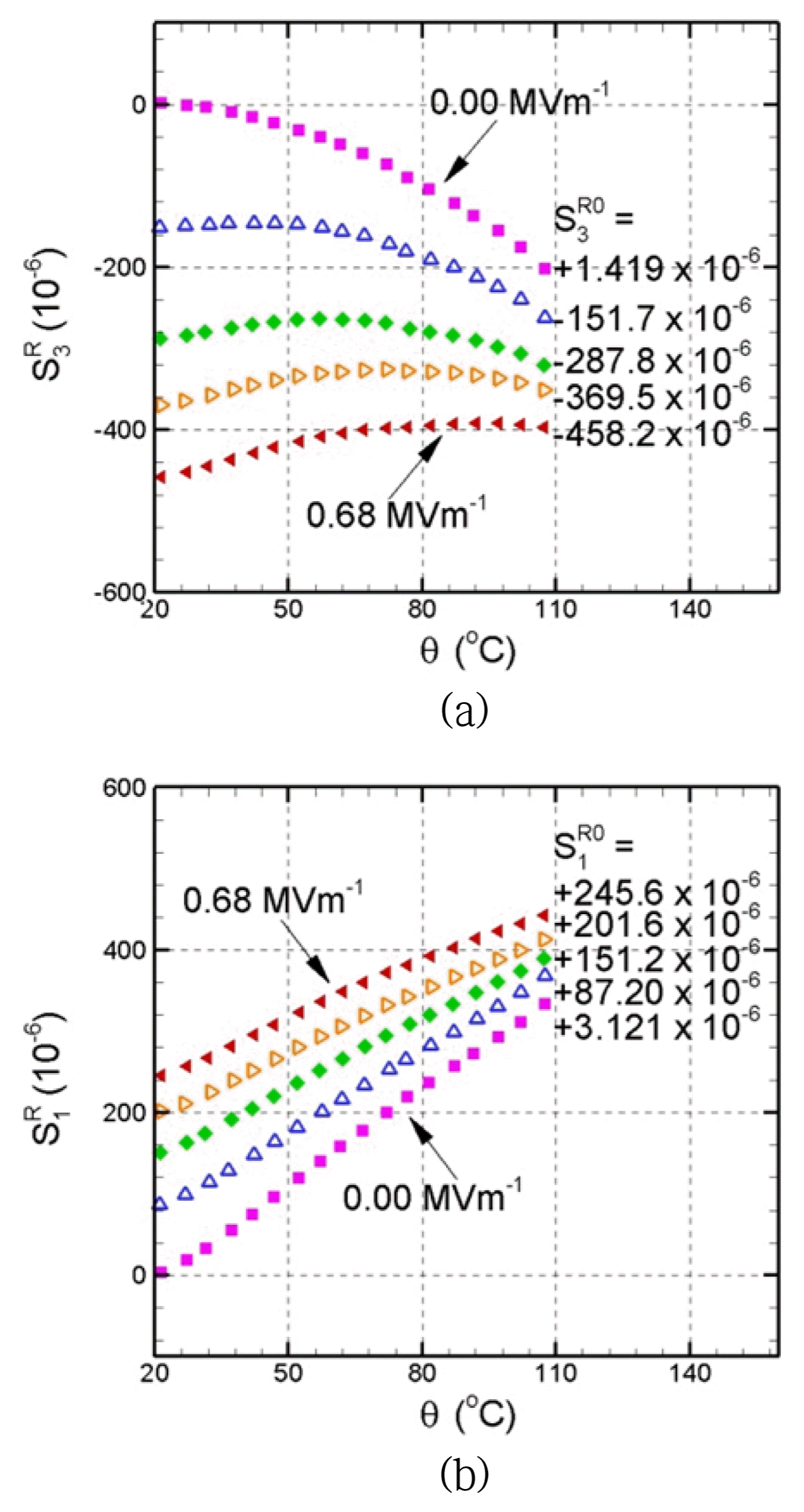1. Introduction
Piezoelectric ceramics are widely used in devices and equipment such as ferroelectric memory (FRAM), ultrasonic motors, sonar detectors, and micro electro mechanical systems (MEMS). Research on the application and development of piezoelectric ceramics is also widely pursued. The application of a significant load or electric field to a piezoelectric system can result in excessive concentration of stress or electric fields in the ceramic material due to the complexity of the system or the presence of defects, which causes unexpected domain switching and rapid temperature changes. As a result, the internal structure of the ceramic material often changes to produce macroscopic nonlinear behavior and variations in the material properties. Degradation in system performance is observed due to such unexpected domain switching. In order to prevent system instability due to nonlinear behavior, experimental observation and analysis of nonlinear behavior of piezoelectric ceramic materials under various load conditions must be made. A wide range of related studies have been carried out. Zhou and Kamlah,1) Liu and Huber,2) and Kim3) observed and analyzed the nonlinear behavior of the materials when electric field and stress are applied at room temperature. Recently, research on the nonlinear behavior of the materials at room temperature has been extended to high temperatures. Lee and Kim4) and Selten et al.5) measured and analyzed the nonlinear behavior of the materials caused by electric fields at room and high temperatures, while Weber et al.6) measured and analyzed the nonlinear behavior caused by stresses at room and high temperatures. Grunbichler et al.7) used the finite element method to predict and understand the nonlinear behavior of piezoelectric actuators due to stress, electric fields, and temperature changes. Also, to develop an empirical formula for predicting experimental observations of piezoelectric materials, Ji and Kim8,9,10) observed and analyzed the nonlinear behavior of the materials when they are subject to stress and electric fields at room and high temperatures.
In the present work, relatively simple empirical formulae for the experiment results of Ji and Kim11) are presented. Moreover, the presented empirical formulae were used to calculate the polarization and strain responses of piezoelectric materials during temperature increases, and comparisons were made with measurements.
2. Experimental Procedure
In the present work, the experimental data of Ji and Kim11) were used to present new formulae for the prediction of ferroelectric ceramic behavior at high temperatures. The experimental method of Ji and Kim11) is presented simply here. For ferroelectric specimens, PZT specimens of regular hexahedron shape with 10 mm sides were used. The followings are the properties of the specimen material, provided by the manufacturer (PZT5H1, Morgan Technical Ceramics, UK): the Curie point is 200°C, coupling factor kp = 0.60, piezoelectric coefficients d31 = −250 × 10−12 mV−1 and d33 = 620 × 10−12 mV−1, elastic compliance coefficients s33 = 21.9 × 10−12 m2N−1 and s11 = 17.7 × 10−12 m2N−1. Here, the subscript 3 refers to the polarization direction; the subscript 1 refers to the transverse polarization direction. Initially, the specimen is poled in the negative direction and a total of 14 electric fields of different magnitude were applied at the reference temperature of 20°C. The range of reference remnant polarization
P 3 R 0 P 3 R
3. Results and Discussion
3.1. Pyroelectric Coefficient and Strain Calculations During Temperature Increases
Electric fields of various magnitudes were applied in the direction opposite to the polarization of PZT specimens, causing poling in the negative longitudinal direction at reference temperature 20°C. Switching is induced by the applied electric field and an internal state of specific reference remnant polarization is obtained. Then, the electric field was removed, and temperature is increased to 110°C. During temperature increases, remnant polarization
P 3 R P 3 R P 3 R 0 P 3 R 0 P 3 R P 3 R 0 P 3 R P 3 R P 3 R 0 P 3 R 0
where, aP refers to the slope of the fitting straight line and bP refers to the intercept of the line at zero temperature. The values of aP and bP are plotted verse
P 3 R 0
Using Eq. (3), one can estimate pyroelectric coefficient p3 when reference remnant polarization
P 3 R 0
Now turn to the calculation of longitudinal and transverse strains. Thermal expansion coefficient is the rate of change in strain with respect to temperature. Thus, Eq. (4) below can be used to calculate strains from measured thermal expansion coefficients.
Among fourteen measured states, longitudinal and transverse strains are calculated for five specific states of remnant strains and plotted with temperature in Figs. 4(a) and (b), respectively. In Fig. 4(a), as the magnitude of electric field increases,
S 3 R 0 S 3 R 0 S 3 R 0 S 3 R S 1 R S 3 R 0 S 1 R S 3 R 0 S 3 R 0 S 3 R 0 S 1 R S 3 R 0 = - 458.2 × 10 - 6 S 1 R 0 = + 245.6 × 10 - 6 S 3 R 0 = - 458.2 × 10 - 6 S 1 R 0 = + 245.6 × 10 - 6
Let us apply the equations in Eqs. (1) - (3) to calculate strains. The same procedure is used for both longitudinal and transverse strains, so only the calculation of longitudinal strain will be dealt with here. The variations of longitudinal thermal expansion coefficient α3 with temperature for five chosen states of
S 3 R 0
where aS3 refers to the slope of fitting straight line and bS3 the intercept of the line at zero the temperature. The distributions of aS3 and bS3 over
S 3 R 0
Using Eq. (7), one can estimate longitudinal thermal expansion coefficient α3 when reference remnant longitudinal strain
S 3 R 0 S 1 R 0
3.2 Comparison of the Proposed Formula and Experimental Results
Pyroelectric coefficient p3 is the rate of change in remnant polarization
P 3 R p 3 = d P 3 R d θ
Changes in remnant polarization
P 3 R P 3 R 0
Substituting Eq. (2) into Eq. (9) gives Eq. (10) below, in which the variation of remnant polarization
P 3 R P 3 R 0
In this work, reference temperature θ0 is 20°C. The values of all coefficients in Eq. (10) are listed in Table 1. Applying Eq. (10) and Table 1 to the data in Fig. 2(a) gives the prediction results shown in Fig. 6. The symbols in Fig. 6 represent the measured data and the curves represent the calculation results by Eq. (10). Fig. 6(a) shows the plots of changes in remnant polarization
P 3 R P 3 R
Experimental formulae for longitudinal and transverse remnant strains
S 3 R S 1 R S 3 R S 1 R S 3 R S 1 R
4. Conclusions
In the present work, fourteen different electric fields were applied to poled piezoelectric ceramic specimens in the direction opposite to polarization in order to reach a specific state of polarization and strains. Then electric field was removed, and the temperature of specimen was increased, along with that of the invar specimens. Pyroelectric coefficients were calculated using remnant polarizations measured during temperature increase, and strains using thermal expansion coefficient. Then, experimental formulae were developed and used to predict pyroelectric coefficient and strains during temperature rises. The predicted results were compared with the experimental results. For all fourteen states investigated, polarization and strain variations were predicted accurately. The predictions for pyroelectric and thermal expansion coefficients were in relatively good agreement with experimental results. Thus this study shows that the suggested experiment-based formulae can be used to predict the macroscopic behavior, i.e., polarization and strain changes, of ferroelectric materials during temperature increases, including changes in thermal properties such as pyroelectric and thermal expansion coefficients.


















